ATV Bill of Sale Form
An all-terrain vehicle or ATV bill of sale is a legally-binding document proving the sale and purchase of an all-terrain vehicle. It provides all the necessary details regarding the seller, buyer, selling amount, plus any other information essential for selling and registering the vehicle. After the seller receives payment from the buyer, they complete the bill of sale form as evidence for the sale.
Why Do I Need an ATV Bill of Sale?
This document is critical in the sale and purchase of an ATV vehicle for various reasons. First, the bill of sale serves as a legally-binding record that the sale transaction happened legally. Second, the form proves that the seller transferred the vehicle’s ownership to the buyer. Third, the form shows all of the terms and conditions surrounding the sale of the ATV such as price, parties, VIN, the vehicle’s title, and deposit.
ATV Bill of Sale Form Details
| Document Name | ATV Bill of Sale Form |
| Other Names | 4 Wheeler Bill of Sale, Four Wheeler Bill of Sale |
| Avg. Time to Fill Out | 10 minutes |
| # of Fillable Fields | 60 |
| Available Formats | Adobe PDF; Microsoft Word |
Must I Notarize My ATV Bill of Sale?
It is not compulsory to do so in all states because every state has its legal requirements. For instance, if you live in states like California or Washington, you will not need to notarize your bill of sale form. However, if the sale happens in states such as Maryland or Montana, you must notarize the form. So, make sure you check what your state requires of your paperwork before you make any moves. Otherwise, your bill of sale could be null and void.
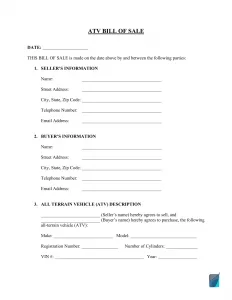
How Can I Write an ATV Bill of Sale Online?
Just like all other vehicle sale documents, an ATV bill of sale form binds legally. Therefore, writing a legally-sound document challenges many ATV sellers. However, that doesn’t mean that you can’t draft the form on your own. If you find it challenging to create a sound bill of sale, you can download templates from our site. But if you wish to write it yourself, you can follow the pattern below. Ensure that the document contains accurate information that can address the following questions:
- Who are the parties involved in the ATV transfer process?
- What is the seller’s name?
- Who sold the vehicle to the current owner?
- Who is buying the ATV?
- What is the vehicle’s purchase price?
- What is the buyer’s postal address?
- What is the seller’s postal address?
- What are the seller and buyer’s email addresses?
- What is the title number?
- What is the model of the ATV?
- Will the purchase have any special sale conditions such as warranties?
- What is the vehicle identification number of the ATV?
- What is the color of the ATV?
- Does it have any special features or mods?
- Does the vehicle have any faults that the buyer should know about?
- What is the method of payment?
- Does it clearly spell out any details about pending payment or delays in remitting it?
- When will the transaction happen?
After addressing all questions, double-check the ATV bill of sale to ensure it is legible. Also, recheck all of the information and signatures on the document to verify their accuracy. After that, make copies for yourself and the buyer.
How Do I Sell My ATV Faster?
After getting all of the necessary information for drafting an ATV bill of sale and what the document should contain, we will now focus on how to sell your ATV.
Step 1. Clean the Vehicle
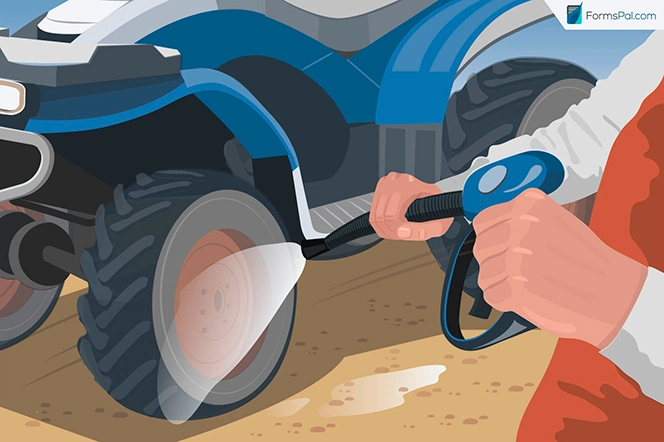
Nobody wants to buy a dirty vehicle that looks tired. Therefore, clean it before letting potential buyers view it and making photos for display. Make sure to clean your vehicle’s exterior and interior thoroughly.
Step 2. Establish Its Current Working Condition
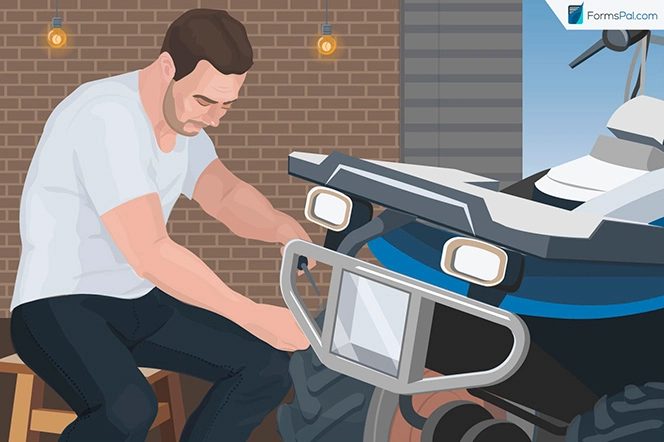
This stage is one of the most important since the customer will buy the ATV based on it. Remember, a customer will still turn down your offer if the ATV isn’t working correctly despite looking new. Checking it for any necessary repairs will let you do them before handing it over to the next owner.
Step 3. Advertise It

Next, advertise it where you know it will sell faster. You can post it on social media, local newspapers, and on car-selling websites to fast-track its sale. Don’t forget that word of mouth is still useful. Therefore, don’t shy away from telling your friends and family about it.
Step 4. Clear Its Title and Acquire Its Registration Details
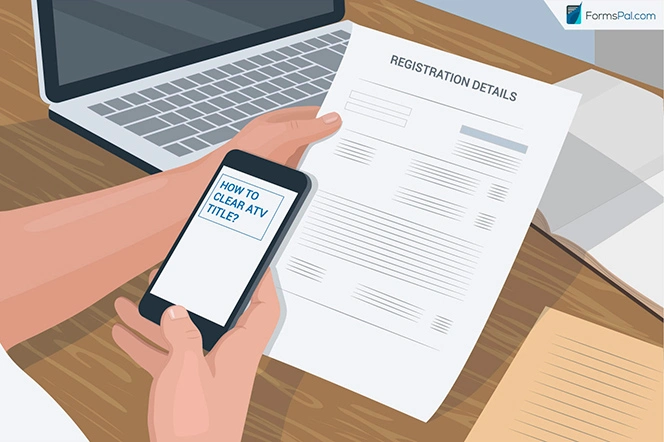
You should also clear its title to ensure that it has no lien or encumbrance. This clearance will guarantee that your prospective customer buys it without doubts or hesitation.
Step 5. Negotiate Its Price

After landing prospects, negotiate the final price for the ATV. Ensure that your price is not too high compared to what the potential customer deems a reasonable market price. Otherwise, you could “age” while still looking for buyers.
Step 6. Fill Out an ATV Bill of Sale Form
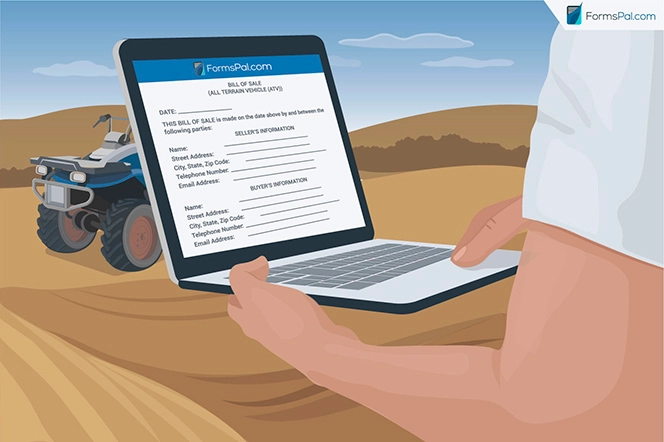
After finding the right customer, fill out the bill of sale. You only need to download the form on our website and fill in all of the necessary info we discussed earlier.
Step 7. Provide Customer Inspection
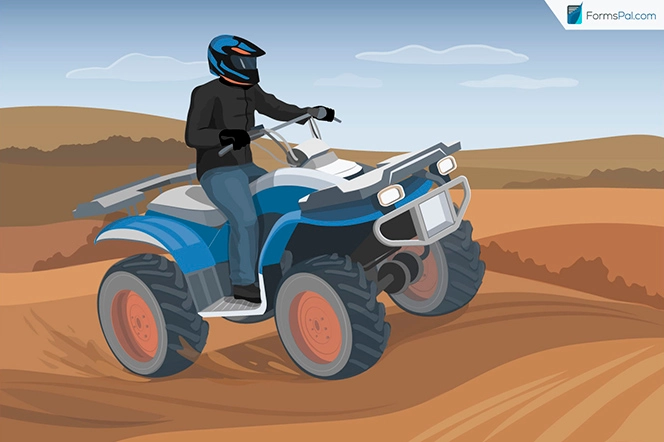
Next, let your chosen customer inspect the vehicle’s working condition. They can do this on their own or using their preferred trusted mechanic.
Step 8. Registering and Transferring the Title to the New Owner

After the new owner is satisfied with the ATV, registering and transferring happens. They can register it and get a title via their local DMV if required by the state.
ATV vs UTV
Off-road travel fans have a broad choice of vehicles to select from. But to make these vehicles your reliable companions in adventurous off-road travel suiting all your needs, you should buy exactly the one you need specifically for your terrain, garage, and budget. You can usually choose between all-terrain vehicles (ATVs) and utility task vehicles (UTVs). They differ in size, price, and functions.
Pricing
By default, ATVs are cheaper than UTVs, but additional equipment and modifications may alter the price considerably. Most off-road drivers tend to add seat belts, roll-cage, advanced suspension features, power-steering, more powerful lighting, and other perks to their vehicles, which may double or even triple the base price of the model. Also, include the protective equipment into the invoice, as riding without safety gear is very dangerous.
Functionality
As the name suggests, ATVs suit all kinds of terrains. Their major benefits include good maneuvering and an ability to develop high speeds. However, an ATV is ideal for one-person travel, so if you want to ride off-road together with a friend, UTVs are more suitable. Besides, UTVs are more customizable to specific terrains (e.g., you can equip the UTV with different wheels when you change the route of travel).
Dimensions
If your garage space is limited or you plan a trip requiring maneuvering in tight spaces, ATVs are a great choice as they are smaller and more compact. However, along with quicker turns, they are less stable and can pose threats to the driver as a result of accidental overturning. UTVs are larger in size, so you should consider them only if you have sufficient storage space. However, the benefits they bring are greater comfort, safety, and an ability to carry passengers.
How to write an ATV Bill of Sale?
Down below, you can find the instructions developed by using the all-terrain vehicle (ATV) form made by our specialists. We strongly recommend using the local official form if possible.
Step 1: Indicate the date when document is created and filled out.

Step 2: Type in the information of each party (seller and purchaser):
- Full legal name
- Address: Street, City, State of residence, Zip code
- Contact information: Telephone number, Email address

Step 3: Fill out the information about the ATV that you’re trying to sell:
- Manufacturer
- ATV’s model
- Number of Cylinders
- Year
- VIN Number
- Identification Number

Step 4: Now, you will need to indicate the way in which you’ll receive money for the ATV.
Enter the purchase date and write the overall amount that must be paid for the motor vehicle. Then, pick one sale method:
- The whole sum straight away. One of the more straightforward options: the ATV owner is provided with the entire amount of money from the purchaser in a single payment and delivers the vehicle to the purchaser on the same day.
- Gift with no consideration paid. This choice allows the seller to gift the purchaser the vehicle without expecting any form of compensation.
- Installments. Specify the downpayment amount as well as the date it has to be given, together with the date by which the full amount has to be handed to the vehicle owner.
The next step is considering the form of payment:
- Cash
- Check
- Cashier’s cheque
- Money order
The very last thing to complete within this part would be to select whether or not all applicable taxes are included in the final cost.
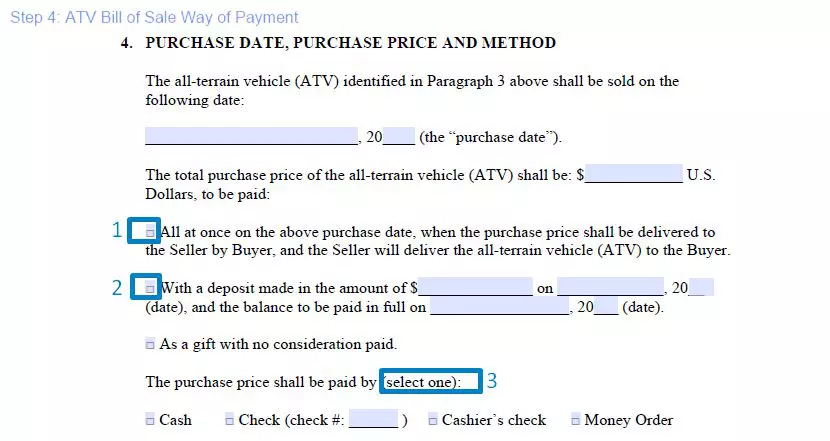
Step 5: Go over standard terms and ensure both parties are familiar with them.
The seller confirms that they are indeed the owner of the ATV described in the document and they have the right to sell it based on the price in the form. The seller also confirms that there are no liens on the ATV and that the information provided in the Bill of Sale is true, accurate and complete to the best of their knowledge
The “as-is” part indicates that the ATV owner gives no warranty and will not be accountable for maintenance after the transaction.
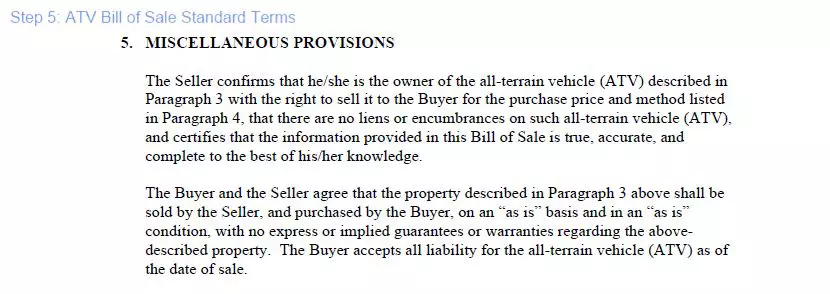
Step 6: Now, the bill of sale form has to be signed.
The buyer’s signature is generally not necessary. Nevertheless, it’s recommended to get the form signed by both parties. To avoid risk, the buyer and seller could find someone who will witness the transaction and sign the bill of sale as well.
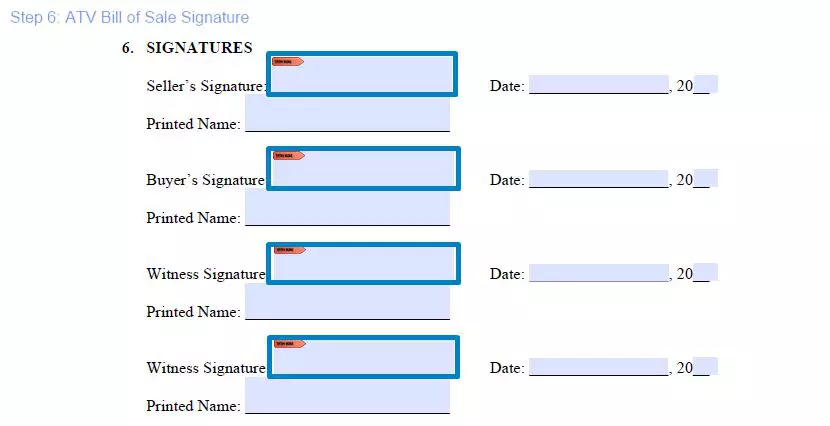
Step 7: Have a notary public certify the document
Using this method, you will have more legal protection. Yet, this is generally completely optional.
In lots of states, a bill of sale form could be requested in the course of title change, so the purchaser should keep the original. As a seller, you could either make a copy and keep it or have a pair of identical documents signed and completed by both parties.


